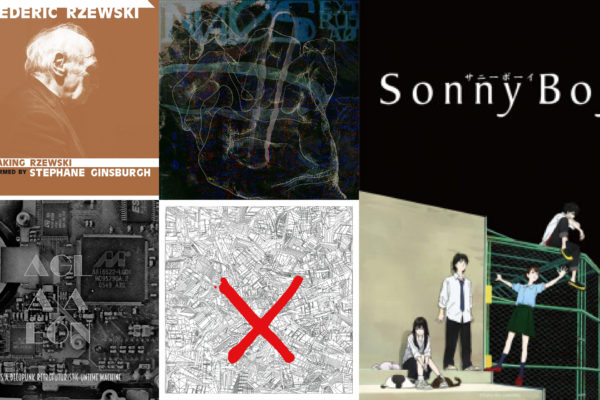Músicas e relacionados, citadas no livro “Ghosts of My Life: Writings on Depression, Hauntology and Lost Futures”, por Mark Fisher (Zero Books, 2014).
00: Lost Futures (futuros perdidos)
There can be few who believe that in the coming year a record as great as, say, the Stooges’ Funhouse or Sly Stone’s There’s a Riot Goin’ On.
Artic Monkeys’ I Bet You Look Good on the Dancefloor: I genuinely believed that it was some lost artifact from circa 1980. I had believed that (Amy Whinehouse’s) Valerie was first recorded by indie plodders the Zutons. Adele’s recordings are saturated with a vague but persistent feeling of the past withotu recalling any specific historical moment.
William Basinski, the Ghost Box label, The Caretaker, Burial, Mordant Music, Philip Jeck: [they shared ] a sensibility, an existential orientation. [“hauntological”]. As to the deeper causes of this melancholia, we need look no further than the title of Leyland Kriby’s album: Sadly, The Future Is No Longer What It Was.
Rufige Kru: Ghosts Of My Life (sampled Japan’s David Sylvian voice on Ghosts) + Terminator – If Jungle celebrated anything, it was the lure of the dark. Dark Rider, Fury, Manslaughter felt like you were being pursued through a near-future brutalist arcade. Goldie first album, Timeless, smoothed out the anorganic angles of Jungle with the use of analogue instruments and an alarming jazz-funk tastefulness.
When Sylvian sings ‘Red Army needs you’ on ‘Cantonese Boy‘, it is in the spirit of semiotic orientalism: the Chinese and Japanese Empires of signs are reduced to images, exploited and coveted for their frisson. [David Sylvian pursuit for authenticity, vide Blemish]
“Just when I thought I was winning”, Tricky’s Aftermath. On ‘Maxinquaye Tricky sounds like ghosts from another solar system.’ Pre-Millennium Tension with its religious mania; Council State and class rage (de Knowle West Boy). 1996’s ‘Tricky Kid‘ was his take on the theme of class dislocation that has preoccupied British pop since at least as far back as The Kinks (including The Associates ‘Club Country‘).
01: The Return of the 70s
Joy Division featured in Michael Winterbottom’s 24 Hour Party People (2002) and assumed centre stage in Anton Corbjin’s Control (2007); Grant Gee’s Joy Division (2007), was most effective at transporting us back to those disappeared times. On Movement New Order was still in post-traumatic stress (they had no idea what they were doing). [In a Lonely Place was Curtis’ song, but it was recorded by a New Order in a zombie state.] If Joy Division were very much a boys’ group, their signature song, ‘She’s Lost Control‘ saw Ian Curtis abjecting his own disease, the ‘holy sickness’ of epilepsy, onto a female Other.
Joy Division provided the Black Atlantic with some sonic fictions it could re-deploy – Grace Jones’s She’s Lost Control, Sleazy D’s I’ve Lost Control or even Kayne West 808s and Heartbreak. As Jon Savage loves to point out, the swarming syn-drums on Insight seem to be borrowed from disco records like Amy Stewart’s Knock on Wood.
Nothing could have been more fitting than that Unknown Pleasures began with a track called Disorder. No heat in Joy Division’s loins [the most Schopenhauerian of rock groups]. “This is the end, beautiful friend” , but there was no radio – it was all a dream.
02: Hauntology
Burial is the kind of album I’ve dreamt of for years; literally. It is oneiric dance music. The effect is as heartbreakingly poignant as the long tracking shot in Tarkovsky’s Stalker (1979) that lingers over sublime objects-become trash. It reminds me of paintings by Nigel Cooke. It’s the Dub City counterpart to Luomo’s Vocalcity.
His first track was Broken Home no EP South London Burroughs. In Untrue Burial instinctively knew that dubbing is about veiling the song, about reducing it to a tantalising tissue of traces, a virtual object all the more beguiling because of its partial desubstantialization. “My favourite tunes were underground and moody but with killer vocals: Let Go by Teebee, Being With You Remix by Foul Play, and I miss being on the bus to school listening to DJ Hype mixes“. “I was listening to these Guy Called Gerald tunes so I cut up a cappellas and made different sentences, even if they didn’t make sense, but they summed up what I was feeling.”
On Theoretically Pure Anterograde Amnesia the album, a tendency in the Caretaker’s music has reached a kind of culmination. The theme was once homesickness for the past. Now, it is the impossibility of the present. Selected Memories From The Haunted Ballroom was a kind of replicant mnemonic implant, a false memory of the tearoom pop of the twenties and thirties. For those of us haunted by the lambent ache of Al Bowlly‘s croon in The Shining and Pennies From Heaven.
A Starway To The Stars (2001) and We’ll All Go Riding On A Rainbow (2003) – swathed sampled British tearoom pop in a gaslit halo of reverb and crackle. His label V/Vm notoriously released a version (?) of Lieutenant Pigeon’s ‘Moudly Old Dough‘. I think The Death of Rave is about the loss in that spirit [of new possibilities] and a total loss of energy in most electornic musics across the board. Kirby’s other project “The Stranger is a darker version of The Caretaker” [Bleakblow was about a grim place on the dark grey days but also beautiful on sunny days. When Did Our Dreams And Futures Drift So Far Apart, a doleful, echo-refracted piano desolately tracks through subdued electronic textures. The Sound Of Our Music Vanishing is a more violent exercise in thwarted recall – here it is as if the memories are rushing in and being obliterated at the same time. The epic When We Parted My Heart Wanted To Die has a swelling, magisterial melancholy that recalls Angelo Badalamenti. 2008’s Persistent Repetition of Phrases was based around a lot of conditions where the sufferer just repeats themselves.
‘Where does the Singer’s voice GO, when it is erased from the dub track?” ‘It’s All Forgotten Now‘. Isn’t Freud’s thesis simply this: patriarchy is a hauntology? Beloved comes to mind often as I listen to Stone Cold Ohio, the outstanding new LP by Little Axe. Even though they are apt to be described as ‘updating the blues for the 21st century’ they could equally be seen as downdating the 21st century into the early 20th. Their dyschronia is reminiscent to the time slips in Ocatvia Butler’s Kindred, where contemporary characters are abducted back into the waking nightmare of slavery. A post 9/11 re-channelling of Blind Willie Johnson’s If I Had My Way.
Ghost Box label sound is about unhomesickness, about the uncanny spectres entering the domestic environment through the cathode ray tube: Belbury Poly‘s Caermaen (from 2004’s The Willows) and Wetland (from 2006’s The Owls Map); The Advisory Circle; The Focus Group.
David Cain also studied medieval music, and he did a great dark folky electronic album called The Seasons… The Radiophonic Workshop whose two stars, Delia Derbyshire and Daphne Oram, became widely recognized only after their death. Wehn I grew up Doctor Who episodes like The Sea Devils haunted me, the way slightly shaky monsters and sets have their own uncanny horror. The loud blasts of Atonal music. Incidently one connection between rave and Ghost Box is the Prodigy;s sampling of the same kind of announcement on Charly.
On Mind How You Go (2005), The Advisory Circle gently trigger drifts down (false) memory lanes, inducing you to recall a mass mediated past which you never quite experienced. 2011’s Music For Dieter Rams was an attempt to bring functional music together with functional design. Also for Rams, Alva Noto dedicated Interim to the designer.
Asher Miniatures: the lugubrious tempo seems to literalise the notion of longing. Artists like Tricky, Basic Channel and Pole started to foreground vinyl crackle at the very moment when records were becoming superseded. William Basinski’s 2002 album Disintegration Loops – a recording of tapes that destroyed themselves in te very process of their transfer to digital – is a paralble (almost too perfect) for the switch from the fragility of analogue to the infinite replicability of digital. Philip Jeck began the extraordinary 2008 version of Gavin Bryars’ The Sinking of the Titanic with nearly 14 minutes of crackle. This same feeling of coming upon other people’s orphaned memories could be heard in the 2009 album Circulations by G.E.S., which appears to be a front for genre-hopping dilettante Jan Jelinek, best known for Loop Finding Jazz Records. The sense that action is continuing beyond what we are hearing remind me of Antonioni’s The Passenger. This same sense of depersonalised tragedy hung over Alphabet 1968, the 2010 album by Black to Comm, aka Marc Richter, the man behind the ‘death ambient’ genre. On ‘Trapez’, reverbed wind chimes create a gentle Narnian snowfall. As so often on this album, the track recalls a running-down music box – one parallel might be Collen’s 2006 album Boîtes à Musique, except that, where Colleen restricted herself to actually using music boxes, Richter loops and sequences his sonic material so that it simulates clockwork.
The allure of this indolent London was touched upon by a certain trakectory in 60s’ rock: the sunny daze of The Kinks’ Sunny Afternoon, The Small Faces Lazy Sunday Afternoon, The Beatles Tomorrow Never Knows and I’m Only Sleeping. Position Normal can be fitted into the venerable English tradition of Nonsense (another Small Faces parallel: Stanley Unwin provided some of his trademark gobbledygook for Ogden’s Nut Gone Flake). The same sense os lyrical dementia is at work on Mordant Music’s 2006 masterpiece Dead Air.
John Foxx’s Tiny Colour Movies is a welcome addition to this decade’s rich cache of hauntological releases (the most (un)timely LP since 1980’s Metamatic). It is a distillation of an aesthetic Foxx has dedicatedly explored since Ultravox’s Systems of Romance. Rudolf Otto’s word for religious experience is the numinous. Foxx instrumental music, also on the Cathedral Oceans CDs, and with Harold Budd on the Transluscence and Drift Music – has been eerily successful in rendering this alien trnaquillity. (the polaroid, a capturing of a haecceity which is itself a haecceity – an impersonal melancholy similar to the oddly wrenching affect you get from a website like Found Photos. Foxx wrote about this effect in his deeply moving short story, The Quiet Man.
The landscape of Darkstar North felt like the verdant Max Ernst forest of Eno’s Another Green World become ash. It is grey as in The Cure All Cats Are Grey from Faith, a record that stood between the spidery psychedelia of Seventeen Seconds and the unrelieved darkness of Pornography. (it has a cover of Human League’s You remind me of Gold). North is like Kayne West’s 808 with all the gloss removed. (alas, auto-tune was popularised by Cher on her 1998 single Believe). Kayne lachrymose android shtick reaches its maudlin depths on the Astonishing Pinocchio Story. This is the kind of Auto-Tuned lament you might expect neo-Pinocchio and android-Oedipus David from Spielberg’s AI (2001) to sing; a little like Britney Spears’s Piece of Me, you can either hear this as the moment when a commodity achieves selfconsciousness, or when a human realises he or she has become a commodity. It’s the soured sound at the end of the rainbow, an electro as desolated as Suicide’s infernal synth-opera Frankie Teardrop. Drake and West dissolutely cycle through easily available pleasures, feeling a combination of frustration, anger, and self-disgust, aware that something is missing, but unsure exactly what it is. This hedonist’s sadness was captured in Take Care’s Marvin’s Room. There’s an affective as well as sonic affinity between parts of Kanyes 808s and My Beautiful Dark Twisted Fantasy and James Blake albums, including Overgrown.
A track such as I Only Know (What I Know Now) is gorgeously insubstantial – it’s the merest ache, Blake’s voice a series of sighs and unintelligible pitch-shifted hooks. The oddly indeterminate – irresolute and unresolved- character of Blake’s music gives it the quality of gospel music for those who have lost their faith so completely that they have forgotten they ever had it.
The digitally-enhanced uplift in the records by producers such as Flo-Rida, Pitbull and will.i.am is like a poorly photoshopped image or a drug that we’ve hammered so much we’ve become immune to its effects. It’s hard not to hear these records’ demands that we enjoy ourselves as thin attempts to distract from a depression that they can only mask, never dissipate. Jay-Z and Alicia Keys’s Empire State of Mind, Kesha’s Tik Tok, Flo Rida’s Club Can’t Even Handle Me Yet – [Dan Barrow] “to give the listener the pay-off, the sonic money-shot, as soon and as obviously as possible”. It doesn’t seduce; it tyrannises. Whereas the digital technology of the 80s and 90s fed the collective experience of the dancefloor, the communicative technology of the 21st century has undermined it, with even clubbers obsessively checking their smartphones (Beyoncé and Lady Gaga’s Telephone – which sees the pair begging a caller to stop bugging them so they can dance – now seems like a last failed attempt to keep the dancefloor free of communicational intrusion). Even the most apparently uncomplicated calls to enjoyment can’t fully syppress a certain sadness. Take Katy Perry’s Last Friday Night. Perry and her friends can never get off: ‘Always say we’re gonna stop/ This Friday night / Do it all again…’ Played at half-speed, this would sound as bleak as early Swans. David Guetta’s Play Hard calls up a similarly interminable repetition. Pleasure becomes an obligation that will never let tup. In a (not at all trivial) sense, partying is now a job.
Sometimes, a free-floating sadness seeps into the grain of the music itself. A sample of Kaoma’s 1989 Lambada on Jennifer Lopez’s 2011 hit On The Floor. Black Eyed Peas’ I Gotta Feeling is ostensibly optimist, there’s something forlorn about it – a Sparky’s Magic Piano-like machinic melancholy intrinsic to the technology itself. The album from which the track comes, The E.N.D. was – like its predecessor, The Beginning – so immersed in Rave that it effectively operated as an act of homage to the genre. Yet, the rave appropriations didn’t function so much as revivals of Rave as denials that the genre had ever happened in the first place.
03: The Stain of Place
Space comes as standard with the Junior Boys, as in So This is Goodbye. In Vocalcity and, to some extent The Present Lover, Luomo dilated the song into an unfolding driftwork. in Junior Boys, it’s as if those wildernesses have crept into the very marrow of the record. In The Idea of North, Glenn Gould suggests that North’s icy desolation has a special pull on the Canadian imagination. It is as cosmically desolated as the Young God’s version of September Song, as arctic-white as Miles Davis’ Aura. When No-one Cares is one of my favourite Sinatra songs, but with the Junior Boys’ version it is like hearing for the first time.
At one point in Chris Petitt’s haunting new film Content, we drive through Felixstowe container port (an informal coda to his 1979 Radio On). The overgrown pill boxes, the squat Martello towers, the rusting groynes which resembled gravestones: this all added up to a readymade science fiction scene: Grant Gee’s Patience (After Sebald) (2011). Lichen as ‘a non-human intelligence’ in Robinson in Ruins by Patrick Keiller (sequel to London (1994) and Robinson in Space (1997). The undiscovered country of Nearby, Robert Macfarlane The Wild Places of Essex, or Julien Temple Oil City Confindential.
One of the many striking things about Handsworth Songs is the serene confindence of its experimental essaysm. At a time when reactionaries once again feel able to make racist generalisations about ‘black culture’ in mainstream media, the Black Audio Film Collective’s undoing of received ideas of what ‘black’ supposedly means remains an urgent project. Trevor Mathison’s astonishing sound design certainly draws upon dub, but its voice loops and seething electronics are equally reminiscent of the work of Test Department and Cabaret Voltaire.




